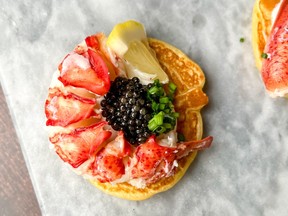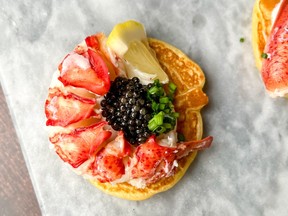Article content
Caviar is having a moment.
Worried though many of us are by the rising cost of food, one of the world’s most luxurious tastes has become the add-on du jour.

We could all use something a little indulgent right about now

Caviar is having a moment.
Worried though many of us are by the rising cost of food, one of the world’s most luxurious tastes has become the add-on du jour.
Article content
After all, if you’re skipping the main to snack on appetizers or happy hour specials, like so many of us seem to be doing these days, you might as well make it special.
So why not add a tiny dollop of caviar to a freshly shucked oyster or retro-cool devilled egg? Or even better, why not savour an unadorned “bump” of roe for the purest caviar experience?
Advertisement 2
Article content
It’s the delicious irony of dining right now: we’re trying to save money—or, at least, not blow the budget to smithereens—but still craving luxuriously maximalist experiences.
Sure, caviar is pricy—you’re looking at $100 and up per ounce—but a little goes a long way. An ounce is enough to garnish two to three dozen canapés. Besides, you can always choose a less expensive alternative.
But before you go for roe, here’s what you need to know.
“Caviar” is the lightly salt-cured roe of sturgeon, the large, long-lived, mostly freshwater fish that are time travellers from prehistory; fossils have been found dating to the Late Cretaceous period (about 100 million years ago), and they likely evolved hundreds of millions of years earlier.
The world’s most revered caviar comes from the Caspian Sea, especially Russia and Iran, but many other countries, including Madagascar, China, Iceland and Canada also produce it, increasingly through aquaculture.
Sadly, sturgeon are critically endangered in many places. Climate change, pollution and conflict around the Black and Caspian seas certainly aren’t helping numbers.
Article content
Advertisement 3
Article content
If you are shopping for caviar, make your purchase through a company that is compliant with CITES (Convention on International Trade in Endangered Species of Wild Fauna and Flora), such as Vancouver-based International House of Caviar.
Here are the main types of caviar:
Beluga is the most luxurious (and expensive) of the caviars and has large, pearl-grey eggs, a subtle flavour and buttery texture.
Osetra is the next best thing, with firm, golden-brown eggs and a rich nutty flavour.
Sevruga is more readily available and affordable, with smaller, crunchier black or grey eggs that have a distinctive pop and intense, briny flavour.

White sturgeon is popular for North American farm-raised caviar, like the high-quality Northern Divine from Sechelt (purchased last year by U.S.-based Carian & Caviar). It has a crisp pop, creamy mouthfeel and natural sweetness.
There are also other, much less expensive types of roe:
Salmon roe (ikura) typically comes from Alaska and features big, rosy-red pearls, with a juicy pop and sweetly briny flavour.
Trout roe from Denmark is similar, but slightly smaller and milder.
Advertisement 4
Article content
Flying fish roe (capelin, tobiko, masago) from Iceland is tiny and crunchy, sometimes dyed and flavoured, often served on sushi.
Lumpfish roe from the North Atlantic is the least expensive and a good choice for canapés and other dishes. It’s small, crunchy and typically dyed red or black, with an umami/salty flavour.
You can enjoy caviar in myriad ways—on pasta, potato chips, scrambled eggs or any number of different canapés—but the most traditional is a classic caviar service.
For this you will need a bowl, ideally crystal, filled with crushed ice, plus three to five small serving bowls for the accompaniments and mother-of-pearl spoons for serving the caviar. (Never use metal; it reacts with the roe and gives it an unpleasant taste.)
Depending on your budget, expect to serve about an ounce of caviar per person. Open the tin just before serving and nestle it into the crushed ice; always keep it well chilled and consume within 24 hours of opening.
Alongside, serve the small pancakes known as blini. In those tiny serving bowls, offer finely chopped chives, hard-boiled eggs and onions, as well as capers and crème fraîche. Guests can then choose the accompaniments they like.
Advertisement 5
Article content
Then again, the very best way to enjoy caviar is with no accoutrements at all. Just mound a small amount onto the back of your hand, between thumb and forefinger, and devour this bump of deliciousness au naturel.
Follow with ice-cold vodka or Champagne, and repeat as desired.
Traditionally, these bite-sized pancakes are made with a yeasted buckwheat batter, but this easy version uses all-purpose flour and baking powder. Perfect for a range of canapés, including caviar with crème fraîche and any other toppings you like.
Makes about two dozen small pancakes.
Combine flour, salt and baking powder in a bowl.
Whisk milk, egg and melted butter together in a separate bowl. Mix into the flour mixture until batter is fully combined. Let sit for about an hour, then whisk again.
Heat 1 tablespoon butter in a skillet over medium-low heat. Drop batter, 1 tablespoon at a time, onto the heated skillet. Cook until bubbles form, 1 1/2 to 2 minutes.
Advertisement 6
Article content
Flip and continue cooking until brown, about 1 minute more. Lay on plate lined with a paper towel to help soak up excess butter. Repeat with the remaining batter.
Can be served warm or at room temperature. Top with crème fraiche, smoked salmon and/or caviar, and garnish with capers, minced red onion, dill, lemon, or as you wish.
Note: If you’re craving a more traditional taste, substitute 1/3 cup of all-purpose flour with 1/3 cup buckwheat flour.
Rich and tangy, crème fraiche can be stirred into soups, mixed into pan sauces, whipped with sugar and served over fruit, or, of course, piped onto blini and topped with caviar.
Makes 1 cup.
Combine cream and buttermilk or sour cream in a small, non-reactive bowl. Cover with a kitchen towel and allow to rest at room temperature (20°C to 22°C) until thickened to desired texture, 12 to 24 hours. Store in the refrigerator for up to one week.
Tip: Transfer to a piping bag for the easiest, tidiest way to apply it to blinis.
Recommended from Editorial
Article content
Source: vancouversun.com